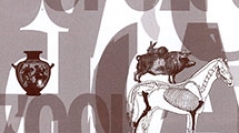

 Anthropozoologica
49 (1) - Pages 47-61
Anthropozoologica
49 (1) - Pages 47-61Archaeozoologists have long examined the relationships between butchery and consumption sites. When applied to historic sites, this distinction between the location of butchery and places of consumption can be informative regarding market economy, long-distance trade and transport using increasingly modern technologies, and the necessity for urban areas to be fed by more rural regions. This paper will explore the archaeozoological markers of participation in a longdistance market economy through the faunal remains from a bone bed deposited in the late 19th century at the Plum Grove Historic Farm, a site located in the American heartland. The faunal remains here suggest that the site’s occupants were involved in a nationwide system providing meat products, likely by refrigerated rail, to an ever growing population in eastern USA.
Market economy, cattle, transport, butchering, refrigerated railcar, American Midwest, historic, farm